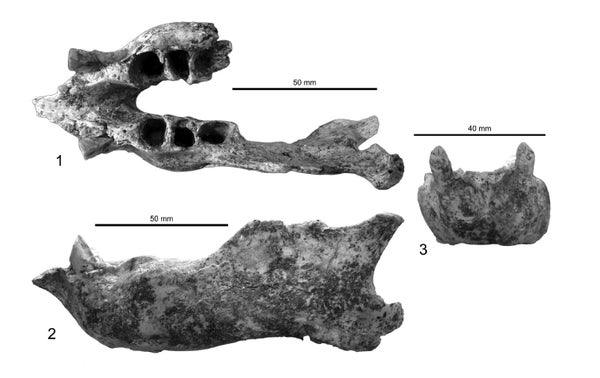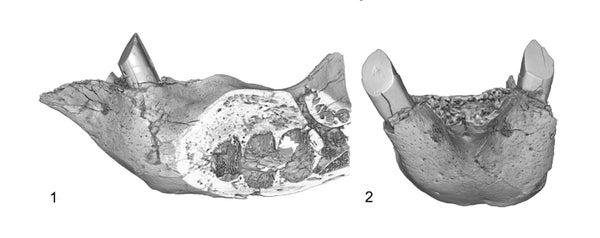This article was published in Scientific American’s former blog network and reflects the views of the author, not necessarily those of Scientific American
Paleontologists are always straining against the pull of the recent. In short, this means that the closer in geologic time you get to the present, the better the fossil record is - we have a better picture of life 50 million years ago than 100 million years ago, and we understand life 100,000 years ago better than 50 million years ago. Yet, despite over two centuries of dedicated searching and study, there's still a great deal left to uncover in even the relatively recent fossil record. A 4.9 million year old giant sloth is one such example.
Zacatzontli tecolotlanensis, named by paleontologists Gregory McDonald and Oscar Carranza-Castañeda, is a sloth that seems out of place. Known only from a lower jaw and two broken teeth, this beast from Jalisco, Mexico is a messenger from another place. That's what makes it so special.
The new sloth lived right in the middle of a critical window for animals of Americas. Between 9 and 1.6 million years ago, as North and South America edged ever closer and eventually joined through prehistoric Panama, various animals moved across the gap. That's why there are jaguars in Brazil and armadillos in Texas. Giant sloths were part of this Great Biotic Interchange, too, and Zacatzontli suggests that the trundling beasts came in waves.
In terms of family relationships, McDonald and Carranza-Castañeda point out, Zacatzontli more closely resembles giant sloths of South American origin than those that eventually evolved in the north. This is despite the fact that giant sloths had already been moving north for millions of years prior. What this means, the researchers note, is that there was an earlier wave of sloths moving from south to north and a later one now represented by Zacatzontli and another giant sloth called Meizonyx in El Salvador. These sloths didn't have an easy time of it. At 4.9 million years ago there was still a significant stretch of water between the continents. But somehow Zacatzontli made it, and now bears the name of the Aztec god of travelers.
On supporting science journalism
If you're enjoying this article, consider supporting our award-winning journalism by subscribing. By purchasing a subscription you are helping to ensure the future of impactful stories about the discoveries and ideas shaping our world today.

Three views of the Zacatzontli jaw. Credit: McDonald and Carranza-Castañeda 2017
Name: Zacatzontli tecolotlanensis
Meaning: Zacatzontli is named for the Aztec god of travelers, and tecolotlanensis is named after the town Tecolotlán where the sloth was found.
Age: Miocene, about 4.9 million years ago.
Where in the world?: Jalisco, Mexico.
What sort of organism?: A giant ground sloth.
How much of the organism’s is known?: A partial lower jaw and two broken teeth.
References:
Royo-Torres, R., Upchurch, P., Kirkland, J., DeBlieux, D., Foster, J., Cobos, A., Alcala, L. 2017. Descendants of the Jurassic turiasaurs from Iberia found refuge in the Early Cretaceous of western USA. Scientific Reports. doi: 10.1038/s41598-017-14677-2
Previous Paleo Profiles:
The Light-Footed Lizard The Maoming Cat Knight’s Egyptian Bat The La Luna Snake The Rio do Rasto Tooth Bob Weir's Otter Egypt's Canine Beast The Vastan Mine Tapir Pangu's Wing The Dawn Megamouth The Genga Lizard The Micro Lion The Mystery Titanosaur The Echo Hunter The Lo Hueco Titan The Three-Branched Cicada The Monster of Minden The Pig-Footed Bandicoot Hayden's Rattlesnake Demon The Evasive Ostrich Seer The Paradoxical Mega Shark The Tiny Beardogs The Armored Fish King North America's Pangolin The Invisible-Tusked Elephant The Mud Dragon The Spike-Toothed Salmon The Dream Coast Crocodile Buriol's Robber Ozimek's Flyer The Northern Naustoceratopsian The High Arctic Flyer The Tomatillo From the End of the World The Short-Faced Hyena The Mighty Traveler from Egg Mountain Keilhau's Ichthyosaur Mexico's Ancient Horned Face Mauricio Fernández's Plesiosaur New Zealand's Giant Dawn Penguin The Orange Sea Lion Mongolia's Ginkgo Cousin The Geni River Frog Isabel Berry's Dinosaur The Whale Caiman The Moab Lizard Yang Zhongjian's Lizard The Little Anubis The Shuangbai Lizard The Wyvern Dinosaur The "Need Helmet" Dinosaur The Jianianhua Dragon The Liaoning Hunter The Dalian Lizard Crompton's Aleodon Jenkins' Amphibian Serpent From the Chinle The Large Ancestor Lizard The Crown Tooth Currie's Alberta Hunter The Elephant Bird Mimic The Crested Thief The Hiding Hunter The Horned Lizard The Silk Bird The Sieve-Toothed Plesiosaur The Defenseless Snout Burian's Lizard The Small Whaitsiid The Beautiful Bird The Fierce Cat The Older One From Melksham The King of the Miocene Iberian Giraffes Miera's Lizard
